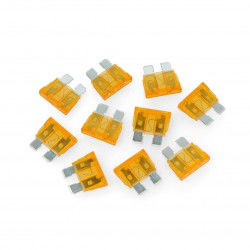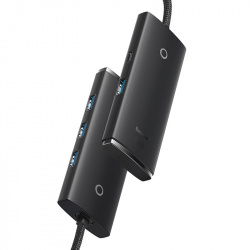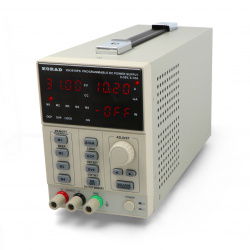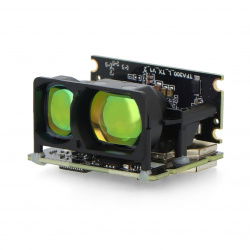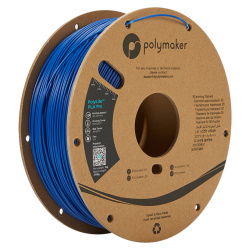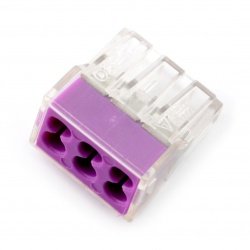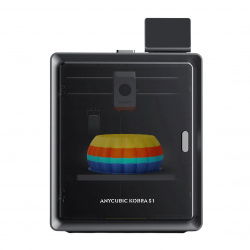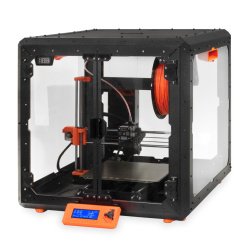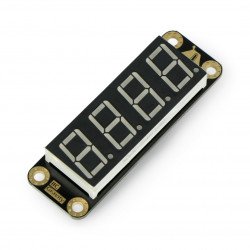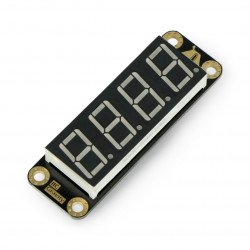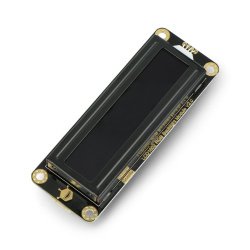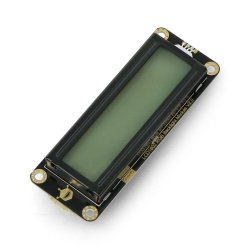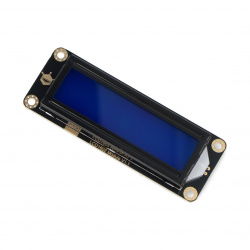The best control over the operating status of electronic devices is achieved when the interface is properly adapted to the specific application. In addition to buttons, switches and LEDs, we can also use LCD displays and segmented LED displays, with which we can graphically present various information (e.g., current and voltage at the output of a laboratory power supply or rotational speed of an electric motor). For this purpose, it is best to use high quality display modules from the Gravity series from DFRobot!
Gravity - displays
Gravity - segment display 4-digital I2C - green - DFRobot DFR0645-G
Four-digit, 8-segment Gravity series display with adjustable 8-level brightness levels, The modules are equipped with an I2C port compatible with the Gravity...Gravity - segment display 4-digital I2C - red - DFRobot DFR0645-R
4-digit, 8-segment Gravity series display , allows you to adjust the brightness of the displayed characters, thanks to 8-stage adjustment, The device has an I2C port...DFRobot Gravity - 2x16 I2C LCD display - black with RGB backlight
LCD display 2x16 characters with black backlight, it can display the font in any colour from the RGB palette. Communicates with two-wire I2C bus. The kit includes a cable...Gravity - segment display 8-digital I2C - green - DFRobot DFR0645-R
The DFRobot Gravity 8-digit, 8-segment display allows you to control the brightness level of the characters displayed, thanks to a 16-degree adjustment. The device...DFRobot Gravity - 2x16 I2C LCD display with RGB backlight - for Arduino
LCD display 2x16 characters with backlight in any color palette RGB. It communicates with the two-wire I2C bus. The kit includes a cable adapted to Gravity DFRobot IO Expansion...DFRobot Gravity - 2x16 I2C LCD display - gray
LCD display 2x16 characters with backlight in gray color. Communicates via two-wire I2C bus. The set includes a cable adapted to the DFRobot Gravity IO Expansion Shield.DFRobot Gravity - 2x16 I2C LCD display - blue
LCD display 2x16 characters with backlight in blue. Communicates with two-wire I2C bus. The kit includes a cable adapted to Gravity DFRobot IO Expansion Shield.DFRobot Gravity - 2x16 I2C LCD display - green
LCD display 2x16 characters with backlight in green. Communicates with two-wire I2C bus. The kit includes a cable adapted to Gravity DFRobot IO Expansion Shield.Gravity - segment display 8-digital I2C - red - DFRobot DFR0646-R
The 8-digit, 8-segment Gravity series display allows you to adjust the brightness of the characters displayed, thanks to a 16-degree adjustment. The device has an I2C...See also
- Gravity - starter kits
- Gravity - base hats
- Gravity - accelerometers and gyroscopes
- Gravity - actuators
- Gravity - gas & dust sensors
- Gravity - medical sensors
- Gravity - distance sensors
- Gravity - current sensors
- Gravity - temperature sensors
- Gravity - force sensors and limit switches
- Gravity - light and colour sensors
- Gravity - LED
- Gravity - encoders and potentiometers
- Gravity - converters
- Gravity - communication modules
- Gravity - sound modules
- Gravity - relays
- Gravity - buttons, keys and joysticks
- Gravity - cables
Segment displays
Gravity Series segment displays come as four and eight digit displays in red and green. Apart from numerals, the segment displays can also display some letters of the Latin alphabet and some special characters - depending on the designer's imagination. The segments of a single display character are four vertical lines, three horizontal lines and a dot. By default, the segments are arranged in the shape of the number "8" with a dot placed in the lower right corner of the segment section for a single character. In essence, each individual segment is an LED. These LEDs can be connected to each other in a common cathode or common anode topology. If you want to implement the display control in a purely hardware-based manner, i.e. without writing a program for a microcontroller, then it is best to use a specialized IC. Such chips include the CMOS 4511 controller (for common cathode displays) and the TTL equivalent, the 7447, for internally connected common anode displays. Thus, for displays with segments connected in a common cathode topology, to make a single segment light up, a voltage must be applied at the anode side of the segment, and vice versa for displays with a common anode - the segment cathode must be connected to ground. Depending on the supply voltage of the displays, select the current limiting resistors for each individual segment. For example, when supplying a standard display from a 5.0V source and considering a voltage drop of about 2.0V on a single segment and a current consumption of about 15mA, choose the resistor with the closest possible value so that a voltage of about 3.0V is deposited on it.
LCD displays
Liquid crystal displays from DFRobot's Gravity series, offered by Botland store, are offered in 2x16 size, i.e. the display can simultaneously display up to two lines of text, sixteen characters each. A single letter, number or special character displayed on the display matrix occupies an area of five columns and seven or eight rows (5x7 or 5x8). The last row is usually reserved for a horizontal cursor that flashes when text is entered. As the name implies, an LCD (Liquid Crystal Display) uses the physical properties of liquid crystal molecules. The electric field strength distribution in the LCD structure, is controlled by the voltage that powers the display. This field strength distribution changes the light polarization of the crystalline molecules. Unlike single LEDs and those used in conventional segmented displays, liquid crystal displays offer higher resolution and can therefore be used to present more complex graphical information, including real-time animation. The LCD display is controlled via the I2C interface, which transmits information to 4- or 8-bit data and command registers.






























































































































































































































































































































